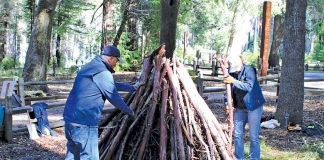A report on the Conjunctive Use Planning Process was met with some skepticism and some support by members of the public who participated in last week’s meeting of the San Lorenzo Valley Water District (SLVWD).
Having been awarded a $330,000 grant last year from the Wildlife Conservation Board to develop a “San Lorenzo Watershed Conjunctive Use and Baseflow Enhancement Plan,” the SLVWD Board of Directors voted to spend an additional $8,000 of its own money to hire a consultant of its choice for a Water Availability Assessment, which is necessary for the larger conjunctive use plan.
According to John Ricker, Water Resources Division Director for the County of Santa Cruz, which is a partner in the grant funded study, “conjunctive use is a way to move water around and improve the reliability of water supply in the aquifer for both the water district and rate-payers, as well as improve stream flows for the fish in the summer.”
Ricker explained conjunctive use at the SLV Water District meeting as a plan to better balance and transfer water consumption from wells and groundwater sources drawing from the Santa Margarita Groundwater Basin with the water available from stream and rivers- with the goals of re-charging the aquifer and ensuring strong river flows during summer months.
“The plan will allow us to compare all the scenarios we can come up with, and provide us with the data we need to make the best decisions,” said Jen Michelsen, Environmental Programs Manager for the SLV Water District. “Which will ultimately allow us to better manage our water resources sustainably,” Michelsen added.
Michelsen explains there are basically three different water systems making up the SLV Water District, each with its own sources: the north system, serving the north end of the SLV Valley and heavily dependent on stream flow; the Felton system, drawing from Fall Creek in the winter and groundwater sources in the summer; and the south system, drawing solely from groundwater, and sharing the aquifer with the City of Scotts Valley Water District.
“We’ve already built the inter-ties between these systems,” Michelsen said. “But we’re only allowed to use them in the case of emergencies. With the conjunctive use plan, and after the environmental review of our preferred options, we can use these inter-ties on a more regular basis to better manage our water resources,” Michelsen said.
An option requiring more information, according to Michelsen, is the rights of the SLV Water District to 313 acre feet of water from Loch Lomond, that will require treatment before it can be consumed.
Previous studies have shown low flow levels in the San LorenzoRiver during summer months have a limiting effect on the population of juvenile steelhead. Increased flow into the San Lorenzo Valley Watershed by streams such as Fall Creek is vital to the recovery of the threatened species, according to these studies.
The San Lorenzo Watershed Conjunctive Use and Baseflow Enhancement Plan should be completed the end of 2019, according to Michelsen. It is being developed through a partnership between the county and the SLVWD, with support from the Scotts Valley Water District and City of Santa Cruz.










